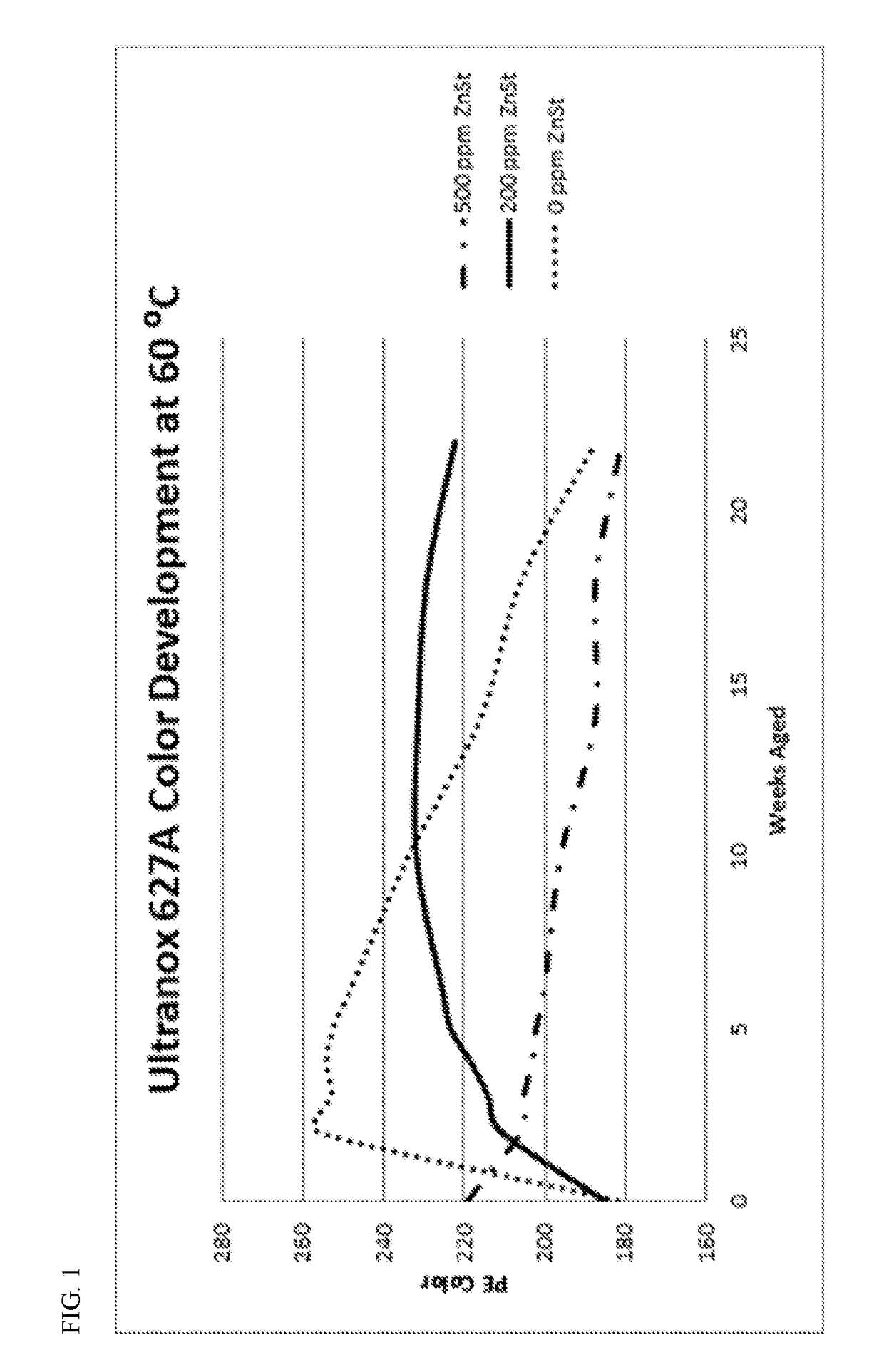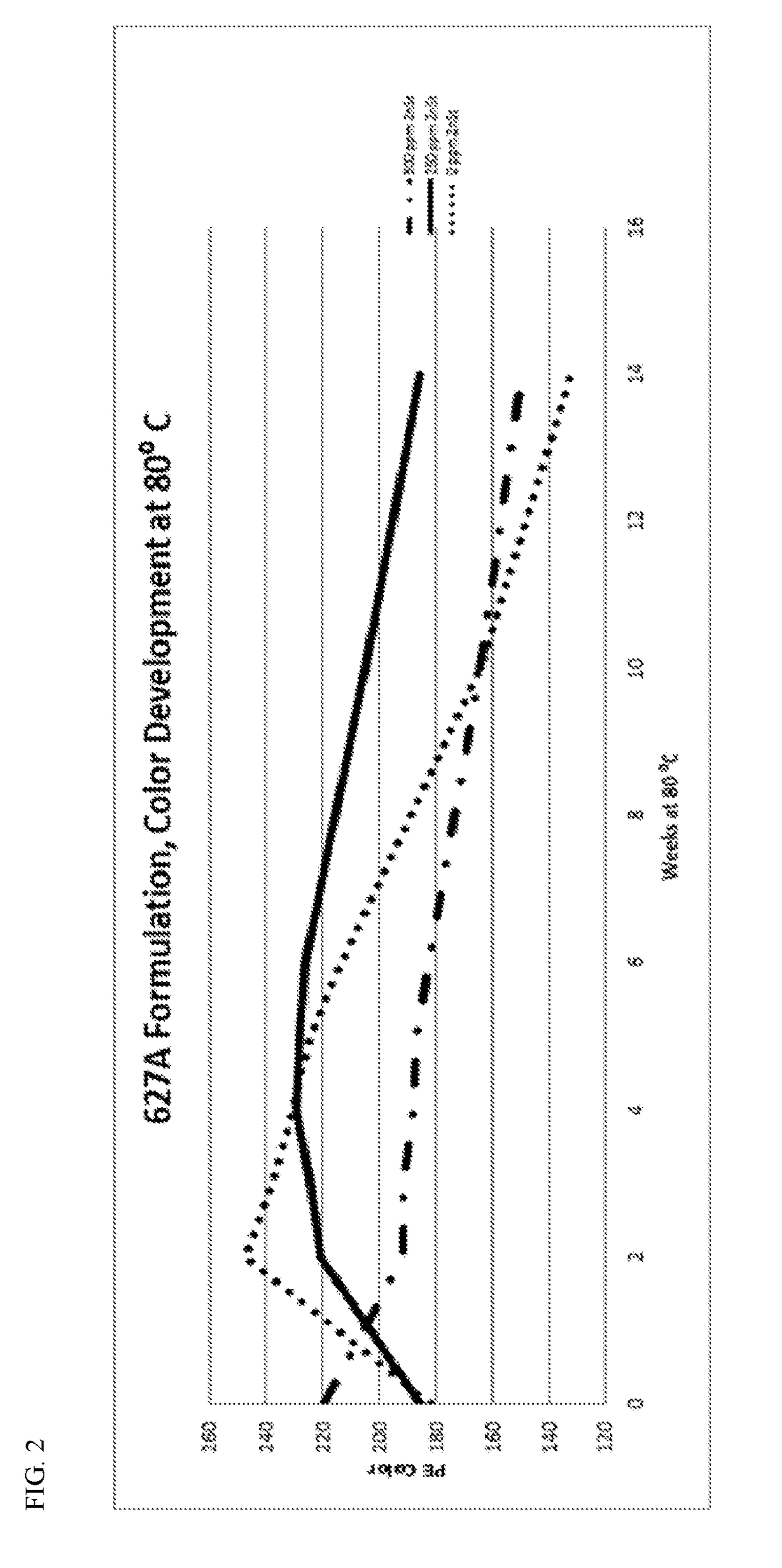Methods for Improving Color Stability in Polyethylene Resins
a technology of polyethylene resin and color stability, which is applied in the direction of metal/metal-oxide/metal-hydroxide catalyst, physical/chemical process catalyst, metal/metal-oxide/metal-hydroxide catalyst, etc., can solve the problems that ethylene polymers that contain a phenolic antioxidant can exhibit color formation, and achieve the effect of improving long-term color stability, and reducing color formation
- Summary
- Abstract
- Description
- Claims
- Application Information
AI Technical Summary
Benefits of technology
Problems solved by technology
Method used
Image
Examples
example 1
[0094]In Example 1, polymer compositions were produced with the titanated-chromium based polyethylene, 750 ppm of IRGANOX™ 1010, 750 ppm of IRGAFOS™ 168, 750 ppm of ULTRANOX™ 627A, and either 0, 200, or 500 ppm of zinc stearate.
[0095]FIG. 1 illustrates the PE Color Number for pellets of the three polymer compositions after aging at 60° C. for over 20 weeks. A higher PE color number reflects less yellow / off-color formation. Unexpectedly, the polymer composition containing 200 ppm of zinc stearate had the most consistent and stable color; the PE color number was relatively constant at 220-240 from 5 weeks to over 20 weeks. Additionally, the PE color number for the polymer composition with 200 ppm of zinc stearate was far superior to that of an otherwise identical composition containing 500 ppm of zinc stearate.
example 2
[0096]In Example 2, polymer compositions were produced with the titanated-chromium based polyethylene, 750 ppm of IRGANOX′ 1010, 750 ppm of IRGAFOS™ 168, 750 ppm of ULTRANOX™ 627A, and either 0, 250, or 500 ppm of zinc stearate.
[0097]FIG. 2 illustrates the PE Color Number for pellets of the three polymer compositions after aging at 80° C. for 14 weeks. A higher PE color number reflects less yellow / off-color formation. Unexpectedly, the polymer composition containing 250 ppm of zinc stearate had the most stable color number and least off-color; the PE color number was over 200 for 2-10 weeks at 80° C. Additionally, the PE color number for the polymer composition with 250 ppm of zinc stearate was far superior to that of an otherwise identical composition containing 500 ppm of zinc stearate.
[0098]The Δcolor / Δtime for the polymer composition with 250 ppm of zinc stearate in the 1-10 week range at 80° C. was only about 30, whereas the Δcolor / Δtime for the polymer composition with 500 ppm...
example 3
[0099]In Example 3, polymer compositions were produced with the titanated-chromium based polyethylene, 750 ppm of IRGANOX′ 1010, 750 ppm of each phosphite antioxidant (750 ppm total, if only one, and 1500 ppm total, if two), and 250 ppm of zinc stearate.
[0100]FIG. 3 illustrates the PE Color Number for pellets of the five polymer compositions after aging at 80° C. for 14 weeks. A higher PE color number reflects less yellow / off-color formation. Unexpectedly, at 250 ppm of zinc stearate, all of the polymer compositions containing either a diphosphite or both diphosphite and monophosphite (1:1 weight ratio) had excellent long-term color stability; the PE color numbers were over 210 for up to 14 weeks at 80° C. Additionally, the PE color number for the polymer composition containing only a monophosphite (IRGAFOS™ 168) with 250 ppm of zinc stearate was far worse than that of otherwise identical compositions containing either a diphosphite or both diphosphite and monophosphite.
PUM
| Property | Measurement | Unit |
|---|---|---|
| temperature | aaaaa | aaaaa |
| densities | aaaaa | aaaaa |
| densities | aaaaa | aaaaa |
Abstract
Description
Claims
Application Information
 Login to View More
Login to View More - R&D
- Intellectual Property
- Life Sciences
- Materials
- Tech Scout
- Unparalleled Data Quality
- Higher Quality Content
- 60% Fewer Hallucinations
Browse by: Latest US Patents, China's latest patents, Technical Efficacy Thesaurus, Application Domain, Technology Topic, Popular Technical Reports.
© 2025 PatSnap. All rights reserved.Legal|Privacy policy|Modern Slavery Act Transparency Statement|Sitemap|About US| Contact US: help@patsnap.com



